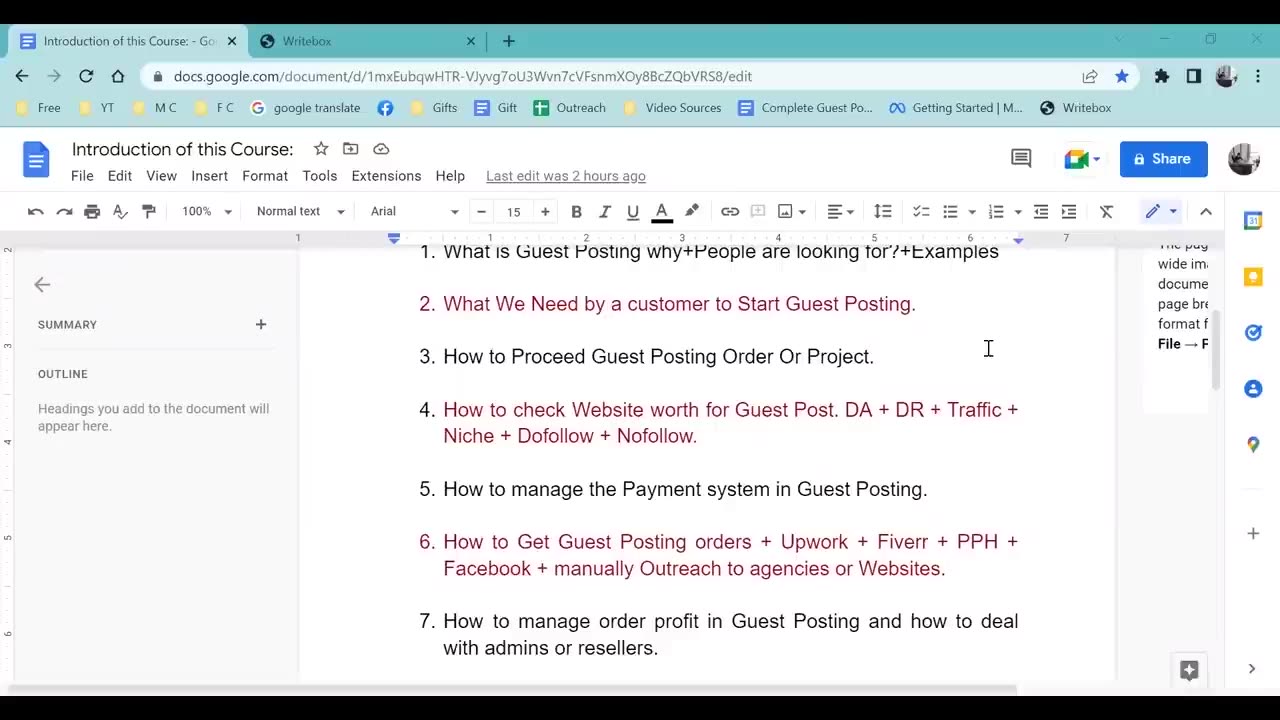Premium Only Content

Guest Post full Course in Urdu Guest Posting Course
Creating a full guest posting course involves a systematic approach to ensure you provide valuable and actionable content to your learners. Here's a step-by-step guide on how to create a guest posting course:
1. Define Course Objectives:
Clearly outline the goals of your course. What should learners achieve after completing the course? Define the skills, knowledge, and outcomes you want to deliver.
2. Identify Target Audience:
Determine who your course is intended for. Are you targeting beginners, intermediate writers, or advanced marketers? Understanding your audience helps tailor your content accordingly.
3. Plan Course Modules:
Divide your course into modules or sections based on different aspects of guest posting. For example:
Introduction to Guest Posting
Finding the Right Guest Posting Opportunities
Crafting Effective Pitches
Writing Compelling Guest Posts
Outreach and Relationship Building
Metrics and Tracking
4. Develop Course Content:
For each module, create content that includes videos, written guides, downloadable resources, quizzes, and assignments. Mix different formats to keep learners engaged.
5. Record Video Lectures:
Record video lectures where you explain concepts, demonstrate processes, and provide insights. Use screen recording software if needed. Keep the videos concise and engaging.
6. Create Written Guides:
Develop detailed written guides, step-by-step instructions, and templates that learners can reference. Make the content actionable and easy to follow.
7. Interactive Elements:
Include interactive elements such as quizzes to reinforce learning and assignments that allow learners to apply what they've learned.
8. Guest Expert Contributions:
Invite guest experts who are experienced in guest posting to provide insights, tips, and real-world examples. This adds credibility and diversity to the course.
9. Choose a Platform:
Select a learning management system (LMS) to host your course. Popular options include Teachable, Thinkific, Udemy, or even creating a dedicated section on your website using plugins.
10. Build the Course:
Organize your content within the chosen platform. Structure the course logically, making it easy for learners to navigate through modules.
11. Create Engagement Opportunities:
Include discussion forums or community spaces where learners can interact, ask questions, and share their progress. This fosters a sense of community and collaboration.
12. Pricing and Monetization:
Decide whether to offer the course for free, charge a one-time fee, or implement a subscription model. Set up payment gateways if you're monetizing the course.
13. Marketing and Promotion:
Promote your course through various channels such as social media, email newsletters, blog posts, and relevant online communities. Highlight the value learners will gain.
14. Launch and Support:
Launch your course and provide support to enrolled learners. Address their questions, concerns, and provide guidance as needed.
15. Gather Feedback and Iterate:
After the course has run for a while, gather feedback from learners. Use this feedback to improve the course, enhance content, and address any issues.
16. Continuous Updates:
Guest posting practices and platforms can change over time. Regularly update the course to reflect the latest trends and best practices.
Creating a successful guest posting course takes dedication, expertise, and continuous improvement. Focus on delivering value to your learners and helping them achieve their guest posting goals.
-
 59:10
59:10
barstoolsports
11 hours agoThe Shred Line with Coach Gruden, Dave Portnoy, and Steven Cheah | Divisional Round
14.7K2 -
 2:09:40
2:09:40
TheSaltyCracker
5 hours agoHe's Back ReeEEeE Stream 01-19-25
116K212 -
 4:41:03
4:41:03
Due Dissidence
14 hours agoCeasefire IN EFFECT, Bibi WARNS It's Temporary, TikTok BANNED, Chappelle's Pro-Palestine Monologue
30K20 -
 2:15:15
2:15:15
Nerdrotic
7 hours ago $4.67 earnedThe Absolute State of UFOlogy | Forbidden Frontier #088
34.3K9 -
 DVR
DVR
GOP
9 hours agoPresident Trump’s Celebratory Victory Rally
95.3K41 -
 8:46:00
8:46:00
Right Side Broadcasting Network
6 days agoLIVE REPLAY: President Donald J. Trump Holds Inauguration Eve Rally in Washington D.C. - 1/19/25
802K328 -
 2:27:15
2:27:15
vivafrei
15 hours agoEp. 246: Eve of Trump's Inauguration! Confirmation Hearings Analysis! TikTok Goes Dark & MORE!
157K112 -
 LIVE
LIVE
Vigilant News Network
10 hours agoBill Gates’ New Bioterror Project Exposed | Media Blackout
1,409 watching -
 7:56:34
7:56:34
Barry Cunningham
1 day agoWATCH LIVE: TRUMP INAUGURATION MAKE AMERICA GREAT AGAIN VICTORY RALLY - 1 DAY TO GO!!
66.9K50 -
 8:36
8:36
China Uncensored
13 hours agoIs China’s EV Industry Collapsing?
205K123